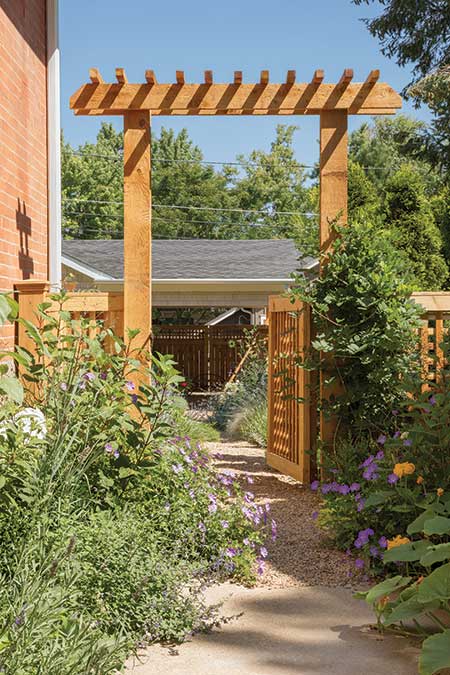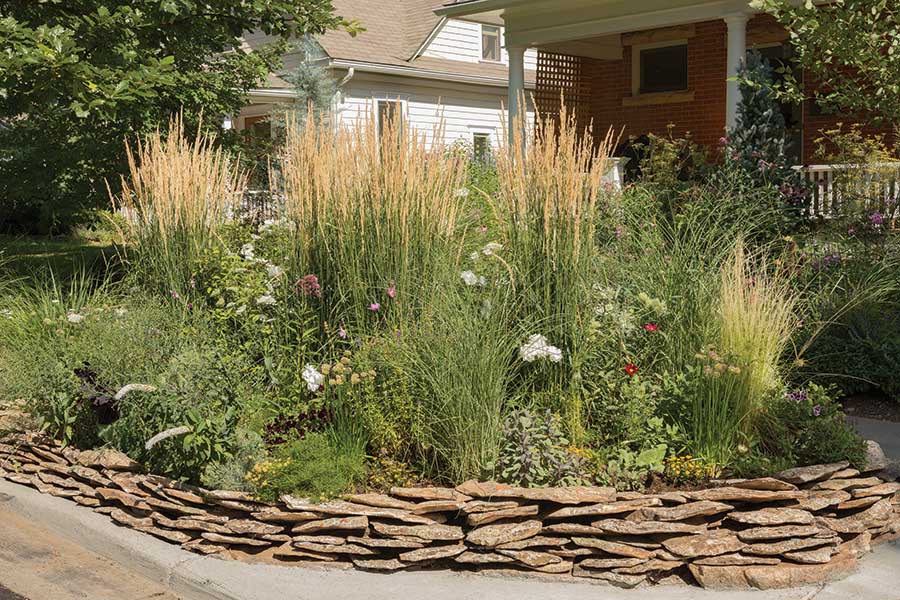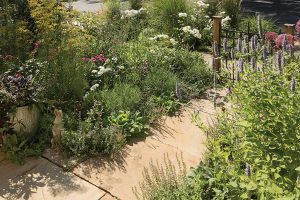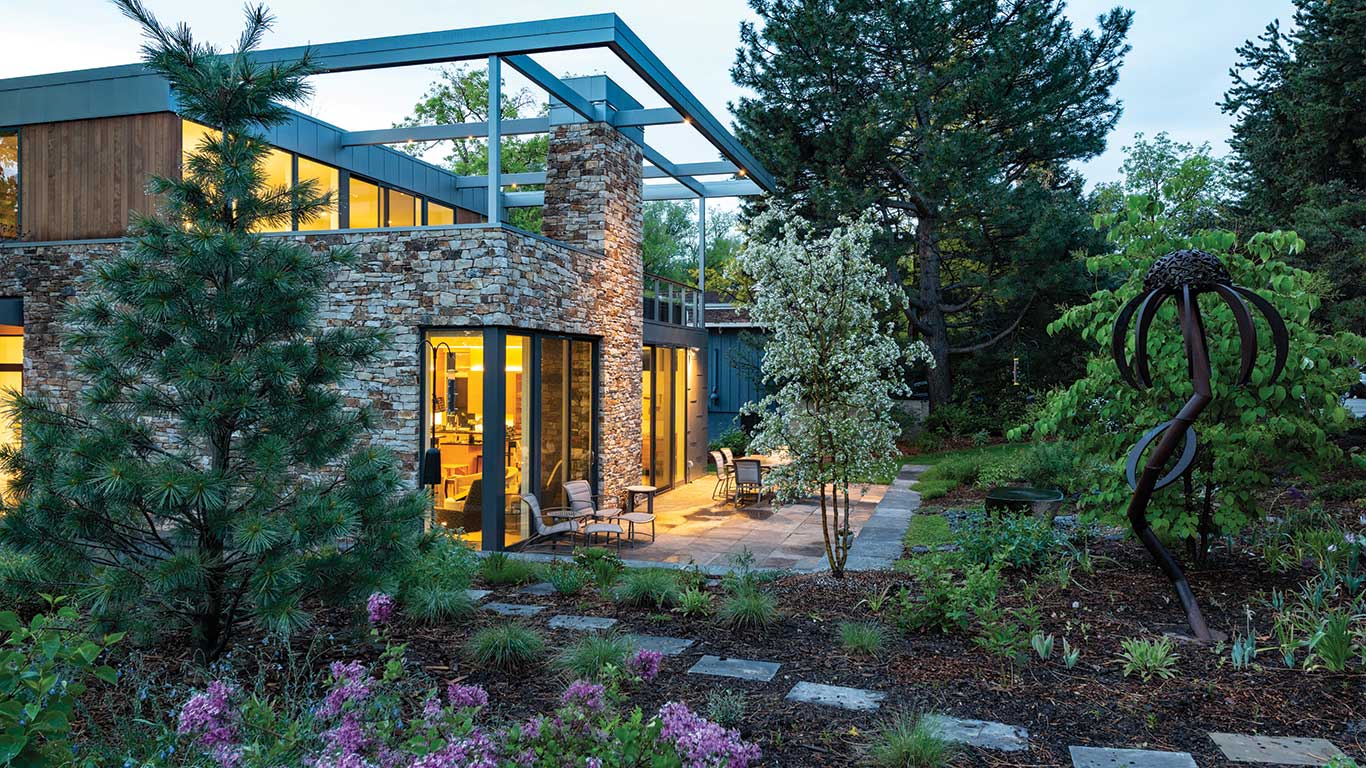Feature Garden: Taking Cues from Nature
02 Jul 2019
There’s a method to the madness in this garden of “organized chaos.”
By Kerry Parry Photos by weinrauchphotography.com It didn’t take long for Sara Shinn and Phil Blake to fall in love with Mapleton Hill after moving there from New Hampshire in 2015. “It reminded us of where we grew up, and it still has that traditional neighborhood way,” says Shinn, who, along with Blake, grew up in Marblehead, Massachusetts. Both yearned to live in a neighborhood with a “strong sense of community,” and Mapleton fit the bill nicely. Although they loved their historic turn-of-the-century home, they weren’t thrilled with its water-hogging yard. “I don’t believe in grass,” Shinn says. “Not here, anyway. I mean, a lush lawn is beautiful, but it never really looks good in a dry climate and does nothing for pollinators.” So she set her sights on the yard while they completed renovations to their home. A natural gardener who worked for a grower and a garden designer before becoming a registered nurse, Shinn appreciates a wild aesthetic—something she picked up in childhood while exploring the sea, the woods and the ponds of Marblehead. Even when she lived in an apartment, she always had pots teeming with plants, she says.

Wild by Design
While the couple no longer has a lawn, Shinn planted around 20 varieties of ornamental grasses that provide natural drifts, flow and spontaneity. She describes her color palette as muted: “mostly shades of green, silver and white, with pops of purple, peach and deep maroon. I rely on dark foliage from plants like dahlia and bronze fennel, and dark flowers—‘Black Knight’ hollyhock, ‘Black Magic’ bachelor’s button and hyacinth bean—for contrast. I prefer texture to color. I take cues from the way plants grow in nature, so my gardens tend to have a wilder character.” Her aesthetic has flourishes of an English garden as well. “I love ‘Beth Chatto’s Gravel Garden,’” she says, of the book by the British author and renowned garden designer. She also draws inspiration from Dutch garden designer Piet Oudolf. “I like things structured and messy all at the same time—controlled chaos, if you will,” she explains. Three ornamental pear trees on each side of the backyard add height and privacy, and a privet hedge provides a neat border. Spring bulbs and wildflowers lend a naturalistic, ethereal quality. “I also have sunflowers. They’re so easy to grow. For two bucks you can have this fabulous display, and the birds love them.”Healing Hopes
When not in the garden, Shinn is an avid marathon and ultradistance runner, which keeps her gardening stamina high. Since moving to Colorado, she’s taken a step back from nursing to put roots down in her new home. She hopes to combine her healthcare expertise with her passion for gardening by creating a community healing garden one day. When Shinn was a single mom of a newborn, she dealt with the sudden, devastating loss of her mother. She learned firsthand the therapeutic qualities of nature and later volunteered at a healing garden in Massachusetts. That garden provided opportunities for counseling, art, horticultural therapy and a place to heal. “This community needs a place like that,” she says. Folks have gotten to know Shinn not only for her garden and the occasional vegetables and bouquets she sets out for passersby, but also for the beautiful wreaths she creates and sells during the holidays. Some include dried remnants from her summer garden, like artichokes and wildflowers. Shinn says her neighbors, avid gardeners themselves, tease her that “no garden is complete without a water feature,” something she may add in the future. “I can’t stop creating,” she says with a shrug. “Nature is in my soul, and my garden provides meaning, purpose and happiness in my life.”MORE PHOTOS
(photos by weinrauchphotography.com)A Buffer Wall of Grasses
 Sara built a moss-rock wall to contain plants in the street-side garden. ‘Karl Foerster’ and maiden grasses buffer the front yard from traffic, and iceberg roses, purple sage, cosmos, bulb blossoms and asters fill the planter, accented by silver santolina.
Sara built a moss-rock wall to contain plants in the street-side garden. ‘Karl Foerster’ and maiden grasses buffer the front yard from traffic, and iceberg roses, purple sage, cosmos, bulb blossoms and asters fill the planter, accented by silver santolina.
Organized Chaos
 Sara describes her garden as “organized chaos,” but she scrupulously picks out plants for their textures and colors, and arranges them according to height, bloom, foliage and other criteria. The truly amazing thing is she grows most of them from seed.
Sara describes her garden as “organized chaos,” but she scrupulously picks out plants for their textures and colors, and arranges them according to height, bloom, foliage and other criteria. The truly amazing thing is she grows most of them from seed.
Workspace
 The detached garage is where Sara crafts seasonal wreathes and floral arrangements to sell. The birdhouse came from the homeowners’ previous New Hampshire home, and is home to purple finches that moved in after a hops vine covered the pole. The planting boxes contain an assortment of veggies that Sara grew from seed, including fennel, artichokes, leeks, salad greens and shiso.
The detached garage is where Sara crafts seasonal wreathes and floral arrangements to sell. The birdhouse came from the homeowners’ previous New Hampshire home, and is home to purple finches that moved in after a hops vine covered the pole. The planting boxes contain an assortment of veggies that Sara grew from seed, including fennel, artichokes, leeks, salad greens and shiso.
The Garden Gate
 The garden gate was a gift from Sara’s father many years ago. It’s a formal yet inviting entry that keeps the porch open and visible from the sidewalk so the homeowners can sit and talk to pedestrians passing by. The naturalistic garden attracts hummingbirds with salvia and coneflowers, and also grows dahlia, potato vine, pincushion, lavender, lambs ears, iceberg roses, nepeta, boxwood, germander, bronze fennel and hyssop.
The garden gate was a gift from Sara’s father many years ago. It’s a formal yet inviting entry that keeps the porch open and visible from the sidewalk so the homeowners can sit and talk to pedestrians passing by. The naturalistic garden attracts hummingbirds with salvia and coneflowers, and also grows dahlia, potato vine, pincushion, lavender, lambs ears, iceberg roses, nepeta, boxwood, germander, bronze fennel and hyssop.
Attracting Butterflies
 Tall purple verbena bonariensis are annuals that Sara grew from seed to attract butterflies. Also pictured are bronze fennel, ‘Abraham Darby’ roses, echinacea, and English thyme. Russian sage and tall ‘Emerald Green’ thuja shrubs provide privacy.
Tall purple verbena bonariensis are annuals that Sara grew from seed to attract butterflies. Also pictured are bronze fennel, ‘Abraham Darby’ roses, echinacea, and English thyme. Russian sage and tall ‘Emerald Green’ thuja shrubs provide privacy. 











